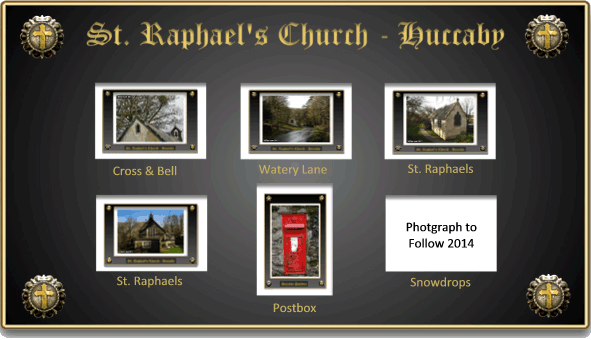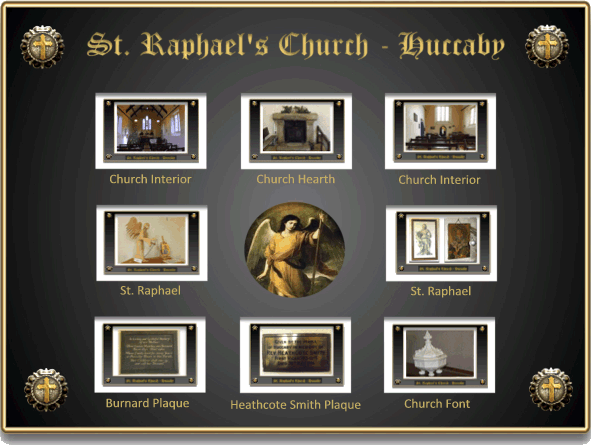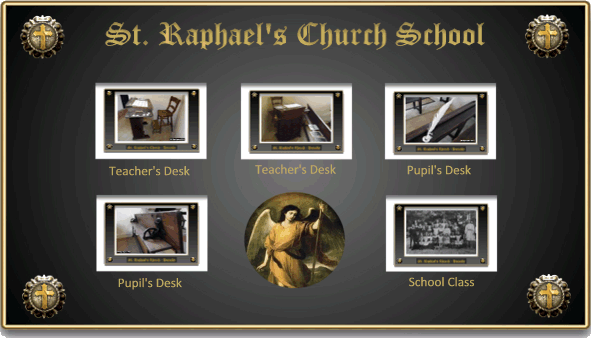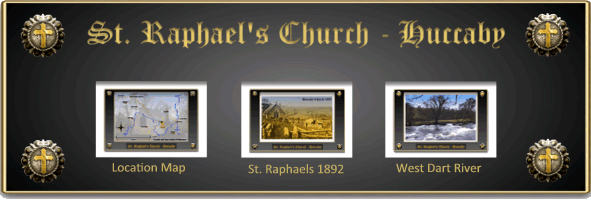
Huccaby was originally one of the Ancient Tenements of Dartmoor consisting of five farmsteads, the earliest documented reference to the place was in 1296 when it was called Woghebye. The suggested etymology of the place-name consists of two descriptive elements – woh meaning crooked and byge meaning curve or bend, Gover et al, p.194 and Clark Hall, p.417/p.61. Both words aptly describe the nearby, large horseshoe-like bend in the West Dart river. Whilst on the subject of place-names, the river flows into a pool known as ‘Church Pool’ which is just below and behind Huccaby farm, Hemery, p.468. This would suggest that the name came into being after the 1860s as that was when the church was first built but is clearly associated with the building.
As Huccaby lay within the bounds of the Forest of Dartmoor its inhabitants were expected to use Lydford as their mother church. During good weather this was a long trek that became arduous when the Dartmoor weather was at its worst which as anyone will tell you was/is quite frequently.
In 1868 or 1869, depending on how you interpret William Crossings words, p.46. or which modern information source you consult, the then rector of Lydford, Morris Fulle,r built a small mission chapel at Huccaby, The whole purpose being to enable the folk living in and around Huccaby to worship at a location that didn’t involve a weekly pilgrimage (see map below). Having gone to the expense and effort of building the chapel it was decided to put the structure to full use and so on Sundays it was a place of worship and weekdays it took on the mantle of a school for the local children. There can be no question that the chapel served a very small and remote area of Dartmoor and as can be seen from the extract from the church’s baptismal records below that its flock either owned or worked on farms.
| Date | Abode | Surname | Occupation |
| 2.5.1880 | Cumstone Hole Farm | Norrish | Farmer |
| 3.1.1881 | Huccaby | Parr | Labourer |
| 11.12.1881 | Huccaby | Basset | Farm Labourer |
| 26.2.1882 | Cumstone Hole farm | Norrish | Farmer |
| 08.10.1882 | Brimpts | Deeble | Farm Labourer |
| 12.11.1882 | Brown Berry | Coaker | Labourer |
| 12.11.1882 | Hexworthy | French | Labourer |
| 25.3.1883 | Sherberton | Coaker | Farmer |
| 10.6.1883 | Sherberton | Coaker | Farmer |
| 21.10.1883 | Huccaby | Parr | Herdsman |
| 8.8.1884 | Sherberton | Coaker | Farmer |
| 14.9.1884 | Littlecombe | Mann | Labourer |
| 8.3.1885 | Huccaby | Skerret | Labourer |
The Saint
Firstly, who was St. Raphael? It is in the book of Tobit where Raphael is largely mentioned, it relates how Tobit was blinded one night. Afterwards Tobit sent his son Tobias on an errand to collect some money in the far off land of Media. To ensure his safety Raphael went along as his protector and guardian, on the journey they stopped at the river Tigris. Whilst washing in the river a large fish attacked Tobias and tried to bite his foot off, under the instruction of Raphael he slew the fish and removed its heart, liver and gall bladder. This was then made into a healing potion and the pair continued their journey.
Upon reaching Media Tobias met a woman called Sarah who he intended to marry, however she was possessed by Amadeus a demon of lust which meant everyone she married died, as had happened to her seven previous husbands. Raphael told Tobias to burn the fishes liver and heart on their wedding night which would ensure the demon was driven away. Having done so the demon fled to Upper Egypt with Raphael hot on his trail. When he finally caught up with the demon it was bound and sent back to Hades. After the wedding Tobias and Sarah returned to his home were he used the fish gall to heal his father’s blindness. Having completed his mission Raphael returned to Heaven.
In the New testament Raphael is credited with being the angel that descended into the pool of Bethesda where after his visit all the infirm gathered there were healed.
Today, Raphael is recognised as being one of the seven archangels, his name means ‘God has healed’ which is apt considering the stories of Tobias and the pool at Bethesda. In religious art he is often depicted alongside two other archangels; Michael and Gabriel but is distinguishable by the presence of Tobias and the fish and due to his exploits Raphael has become the patron saint of healers, Farmer, p.243. This patronage encompasses physicians, nurses and all other kinds of health workers along with associations with travelers, matchmakers and in the Catholic world – sailors. Originally Raphael’s feast day was the 24th of October but this was later moved to join that of St. Michael and Gabriel on the 29th of September.
The big claim to fame for Huccaby church is that it is the only Anglican church in Great Britain to be dedicated to St. Raphael.
The Church Exterior.
The actual building was erected on the site of what Crossing described as being cottages of “great age” which he made a point of stating were thatched with rye straw, Crossing, p.46. This in itself suggests that the building/s dated back to at least the 1700s if not earlier. The reason being that in Devon the use of rye straw for thatching had virtually disappeared by 1808. This was due to the fact that the rye crop had largely been replaced by wheat and this straw was the common thatching material, Cox & Thorp, p.44, however, today it is known that these cottages were in fact a longhouse.
As of October 1987 the church became a Grade II listed building (English Heritage Building ID: 92736) which in one sense gives it some protection but in another has proven expensive due to formalities involved with the recent improvements.
According to English Heritage a formal description of the church is that it is “constructed of granite rubble walls which were recently re-rendered in an effort to eliminate a damp problem. It is of a basic rectangular plan with no division between the chancel and nave. There are two 2-light granite mullion windows to its right – the left-hand one square-headed, the other, to the chancel, has arched lights. The cart window has 3 arched lights, the central one taller. Inside can be seen an A-frame roof and a magnificent granite hearth.”
The entrance to the church is on the south eastern side of the building along a newly lain granite pathway. At the northwestern end of the building a carved Crux pattee or Greek cross sits on the rooftop and opposite at the southwestern end is the small bell tower with a metal patriarchal cross. Originally the bell would be multifunctional insomuch as it would call the worshipers to church and the scholars to school. The vestry is attached to the southwestern end of the building along with an adjacent toilet. It is in February when the outside grounds are transformed by a carpet of snowdrops an annual spectacle which draws many visitors. At any time of the year there is a deep sense of peacefulness to be found here that is intensified by the melodic sound of the nearby West Dart river flowing along its seaward journey.
Although not directly associated with St. Raphaels is the red post box set into the wall just below the church. The ‘V AND R’ indicates that it was sited sometime during Queen Victoria’s reign (1837 -1901). The date range can be narrowed down slightly more as the first postboxes on Dartmoor were installed in 1857, Jenkinson, p.30.

The Church Interior.
The original chapel had a large, wide hearth which in wintertime was the home to a warming peat fire, Crossing, p.46. Today that same granite fireplace houses a modern woodburner which as peat is no longer freely available serves just as well. This is the first feature to greet you as you enter the church. The aisle leads up through an avenue of benches towards the main altar which is backed by a large, stained glass window depicting the ‘good shepherd’. The funds for this window were given by the Adams family in memory of a young eleven year old, Edward Arthur Adams who died in 1888.
On a small table to the left of the altar is a small, delicately carved wooden figure of St. Raphael at whose feet lie his synonymous fish. Beside the figure is a small easel upon which sits a Greek icon of St. Raphael, this was an gift anonymously donated in 2010. On the nearby wall are two other reminders of St. Raphael, the first is a picture of the famous woodcarving made by the German sculptor Veit Stoss in the 1400s. Beside this hangs another Greek style icon painted on a wooden plaque.
There are several memorial plaques on the the walls, one of these being for the Reverend Heathcote Smith who was the first the first vicar of St. Raphaels. There is another memorial to Olive Burnard who was the daughter of the famous Dartmoor writer, antiquarian Robert Burnard. Her daughter was another Dartmoor notary, Lady Sylvia Sayer who in her lifetime was a great campaigner for the protection of Dartmoor.
One thing the church appears to be missing is a font and the main reason for this being it’s kept in a box until needed for a christening. Clearly with such a compact and fairly modern church the small, very ornate alabaster font more than adequately serves the purpose. As I was told when being shown the font; “you don’t need a bucket of water to christen a baby.”

The School.
A log book of the school dating to 1868 revealed that there certainly was a fee structure which reflected the affability of the parents. Farmers children were charged 3d a week, smaller landowners paid 2d a week and labourers got a slightly lower rate of 2d for the eldest child and 1d for the rest. The catchment area of the school encompassed Hexworthy, Dartmeet, and the farms of Brimpts, Swincombe and Dunnabridge. It appears that attendance levels were a constant problem for the school as there were so many factors which kept the children away from their lessons. Serving such a remote moorland area the weather was the main contributory cause, in poor conditions the children simply could not get to the school and in periods of fine weather they were needed to work on the farm. Again, the baptismal records shown above clearly indicate how much agricultural involvement the children had with their parents either owning a farm or working on one. Even if the father was a farm labourer his children would be expected to lend a hand during busy times of the year.
In 1869 the log recorded that since the school opened only eight out of thirty three children had an attendance record of over two hundred times. Over the following years the attendance levels dropped even further so much so that by 1920 there were only five children going to the school. In 1924 the then Board of Education made the decision to close the school completely which meant the building was solely being used for worship. It was also noted how the teachers often took on the responsibilities of attendance inspector and health visitor. Often they would visit the homes of absent children to see what the problem was which in some cases resulted in some health care work. Martin, p.28.
To this day there is evidence within the church of its one-time scholastic associations as many of the old desks now serve as pews, all sporting the holes in which the inkwells sat along with writing quills. The actual desks were made by a company owned by George N. Hammer of London and worked on a tilting ratchet basis. At the back of the church sits the teachers desk along with a bell, cane and lessons. One may wonder why such furniture is still kept today, the answer is quite simple, on occasions parties of local school children visit to experience what a school of the time was like.

The church is desperately trying to raise funds in order to stop the on-going damp problem and other improvements. In 2010 planning permission was given to rebuild the vestry which will then be used for various social and educational events. These pans have been slightly scaled down and the work will concentrate on damproofing, re-plastering, re-decorating, repairing the chimney and floors. The total sum needed to accomplish the refurbishment is £3,000 and donations can be made via the church website. Contact details, location, service times and event calendar can also be found, by following the link to the church’s’ website above.
The day we visited the church was following the horrendous storm on the night of December 18th 2013. The water was still streaming down the road which gave an indication of the kind of weather the church has to withstand.
So if you are ever in the vicinity do not miss the opportunity to visit this little church with the big character, especially if it’s snowdrop time.


Clark-Hall, J. R. 2004. A Concise Anglo-Saxon Dictionary. London: University of Toronto Press.
Cox, J. & Thorp, R. L. 2001. Devon Thatch. Tiverton: Devon Thatch.
Crossing, W. 1987. One Hundred Years on Dartmoor. Exeter: Devon Books.
Farmer, D. 1997. Oxford Dictionary of Saints. Oxford: Oxford University Press.
Gover, J. E. B., Mawer, A. & Stenton, F. M. 1992 The Place Names of Devon, Nottingham: English Place-Name Society.
Hemery, E. 1983. High Dartmoor. London: Robert Hale.
Jenkinson, T. 2002. Posting a Letter on Dartmoor, Dartmoor Magazine – No. 69. Tavistock: Quay Publications
Martin, E.W. 1958. Dartmoor. London; Robert Hale.
 Legendary Dartmoor The many aspects past and present of Dartmoor
Legendary Dartmoor The many aspects past and present of Dartmoor

Sarah Elizabeth Huckabee Sanders (American campaign manager) ancestory is from Huccaby
Built by my 3 X Great Grandfather William Stone from Chagford. (Source Chagford Parish Magazine January 1868)
My grandmother Millie Coren was a servant at the home of Frederick and Sarah Stone of Hillside, Chagford. Frederick Stone’s occupation on the 1911 census was builder carpenter. Maybe they are your relations?